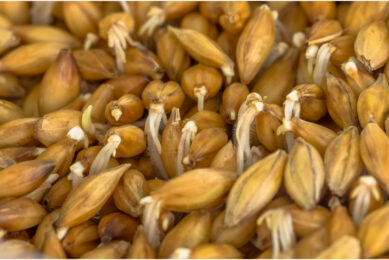‘Barley protein potential replacer of fish meal’
US Missoula-based Montana Microbial Products wants to make barley protein concentrate on a large scale basis for use as fish feed.
Cliff Bradley, co-owner of the company and a microbiologist and biochemist, thinks this grain offers unique qualities. For example, barley is readily available and its protein’s nutritional quality is rich enough to replace fish meal, he said.
Since 2007, Montana Microbial has been working on plant-based proteins with the US Department of Agriculture (USDA) -Agricultural Research Service at its lab in Bozeman.
USDA and Montana Microbial have a patent pending on their production technology.
It has opened a pilot facility in Butte and sent protein samples for testing to the University of Idaho’s Hagerman Fish Culture Experiment Station, Capital Press reports.
Montana Microbial has also collaborated with Clear Springs Foods, which produces more than 10,000 tonnes of fish for human consumption annually. Clear Springs is seeking a lower-cost replacement for fish meal to help satisfy burgeoning demand for fish in the face of rising costs.
Clear Springs successfully ran small-scale testing of barley protein concentrate and hopes to move on to large-scale testing in the fall.
Montana Microbial seeks to provide Clear Springs with the barley protein concentrate it will use in its pilot production.
New production facility
It is also obtaining funds for commercial production and hopes to build a facility in 9-12 months, Bradley said, northeast of Great Falls in Ft Benton in a barley-growing region.
This plant would generate 5,300 tonnes of barley protein concentrate a year and 2 million tonnes of ethanol from the barley waste.
As the global aquaculture sector uses 2.5 million tonnes of fish meal, the market potential is tremendous.
Bradley said that the plan is to build plants in countries that have both fish and barley production.
Rising costs
Clear Springs’ fish meal annual costs have increased by several million dollars over the last five years, said Randy MacMillan, the company’s vice president for research.
Fish meal was about $300 a tonne five years ago, but has gotten as high as $1,600 a tonne. The company uses 5,000 tonnes of it a year. "That’s what’s driving our interest," he said.
Trout need a lot of protein and are carnivorous. Finding a plant-based alternative feed has proved difficult, he said. "Fish meal has a secret ingredient. The X factor is critical for optimum production."
Soy is digestible and has a high level of protein but is high in growth inhibitors and represents only 12% of Clear Springs’ feed ration.
Barley protein is digestible, low in anti-nutritional factors that inhibit growth, doesn’t discolour the flesh and is low in phosphorous, which is an attractive feature because of environmental requirements, he said.
Barley could represent 50% or more of Clear Springs’ feed ration, but the company needs it to be a sustainable and available product and there are no commercial plants producing the concentrate.
The company will need 100 tonnes for its trials but would need 5,000 acres (2,025 ha) of barley annually if it became a viable fish meal replacement.
Clear Springs’ anticipated need of 5,000 acres isn’t much, but worldwide need for a fish meal replacement is much greater and offers a lot of potential for barley growers.











